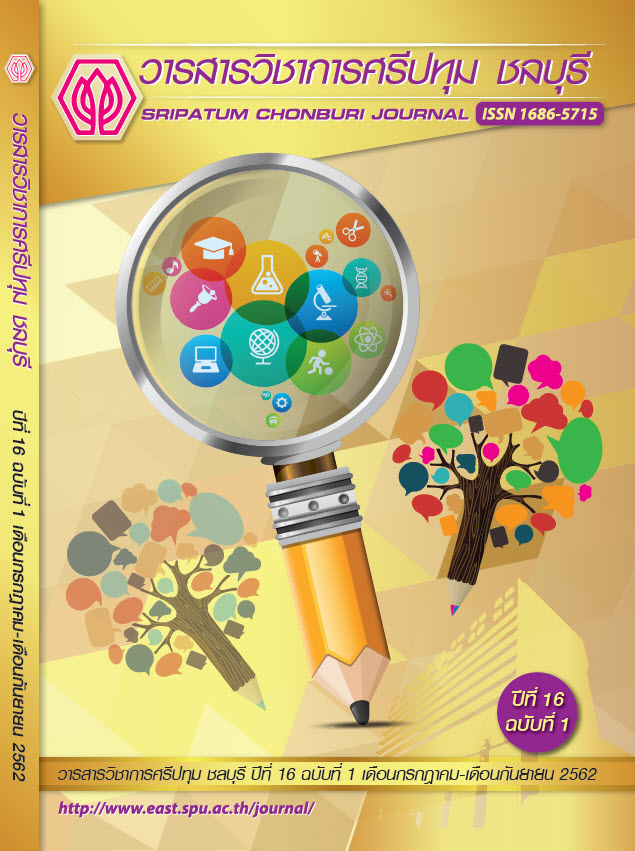การพัฒนากรอบการประเมินความสามารถทางนวัตกรรม ของวิสาหกิจชุมชนที่ผลิตสินค้า หนึ่งตำบล หนึ่งผลิตภัณฑ์
คำสำคัญ:
ความสามารถทางนวัตกรรม, วิสาหกิจชุมชน, หนึ่งตำบล หนึ่งผลิตภัณฑ์บทคัดย่อ
การวิจัยนี้มีวัตถุประสงค์เพื่อระบุชุดของหลักการ มิติ ตัวบ่งชี้ และตัวตรวจสอบของกรอบการประเมินความสามารถทางนวัตกรรมของวิสาหกิจชุมชนที่ผลิตสินค้า หนึ่งตำบล หนึ่งผลิตภัณฑ์ ด้วยการทบทวนวรรณกรรม สัมภาษณ์เชิงลึกกับผู้เชี่ยวชาญ จำนวน 5 คน รวบรวมความคิดเห็นด้วยเทคนิคเดลฟายแบบเรียลไทม์กับผู้เชี่ยวชาญ จำนวน 19 คน จัดลำดับมิติและตัวบ่งชี้ด้วยกระบวนการลำดับขั้นเชิงวิเคราะห์ จำนวน 7 คน ผลการวิจัยปรากฏว่า กรอบการประเมินความสามารถทางนวัตกรรมของวิสาหกิจชุมชนที่
ผลิตสินค้า หนึ่งตำบล หนึ่งผลิตภัณฑ์ ประกอบด้วย 7 มิติ เรียงลำดับความสำคัญ ได้แก่ (1) บรรยากาศขององค์การ (2) วิสัยทัศน์ร่วม การมุ่งไปสู่นวัตกรรม (3) เครือข่าย (4) ผู้นำ (5) ความสามารถทางการเรียนรู้
(6) การเปิดโอกาส ยอมรับสิ่งใหม่ และ (7) การให้ความสำคัญกับตลาดและคู่แข่ง ตามลำดับ รวม 18 ตัวบ่งชี้ และ 62 ตัวตรวจสอบ
เอกสารอ้างอิง
2560 [2562, 8 พฤษภาคม].
กระทรวงอุตสาหกรรม. (2559). ยุทธศาสตร์การพัฒนาอุตสาหกรรมไทย 4.0 ระยะ 20 ปี (พ.ศ. 2560-2579) (ออนไลน์). เข้าถึงได้จาก: http://www.oie.go.th/sites/default/files/attachments/industry_plan/ thailandindustrialdevelopmentstrategy4.0.pdf [2561, 1 กรกฎาคม].
ชุติมันต์ สะสอง และบุญฑวรรณ วิงวอน. (2559). ความร่วมมือของผู้มีส่วนได้เสียและแผนธุรกิจที่มีบทบาทในการขับเคลื่อนกลุ่มวิสาหกิจหนึ่งตำบล หนึ่งผลิตภัณฑ์ (OTOP) ให้มีความได้เปรียบ
ในการแข่งขันอย่างยั่งยืน. วารสารมหาวิทยาลัยนครพนม, 6(1), หน้า 124-133.
พนารัตน์ อุปพงศ์. (2559). การพัฒนาศักยภาพของผู้ผลิตสินค้าหนึ่งตำบล หนึ่งผลิตภัณฑ์ประเภทอาหาร จังหวัดชลบุรี. วารสารวิชาการศรีปทุม ชลบุรี, 12(6), หน้า 216-225.
พยัต วุฒิรงค์. (2557). การจัดการนวัตกรรม: ทรัพยากร องค์การแห่งการเรียนรู้ และนวัตกรรม. กรุงเทพฯ: สำนักพิมพ์แห่งจุฬาลงกรณ์มหาวิทยาลัย.
ธันยมัย เจียรกุล. (2557). ปัญหาและแนวทางการปรับตัวของ OTOP เพื่อพร้อมรับการเปิด AEC. วารสารนักบริหาร, 34(1), หน้า 177-191.
สำนักงานคณะกรรมการนโยบายวิทยาศาสตร์ เทคโนโลยีและนวัตกรรมแห่งชาติ. (2555). นโยบายและแผนวิทยาศาสตร์ เทคโนโลยีและนวัตกรรมแห่งชาติ ฉบับที่ 1 (พ.ศ. 2555-2564). กรุงเทพฯ: สำนักงานคณะกรรมการนโยบายวิทยาศาสตร์ เทคโนโลยีและนวัตกรรมแห่งชาติ.
สำนักนายกรัฐมนตรี และกรมการพัฒนาชุมชน. (2556). ฟื้นฟูโอทอป ต่อยอดสู่สากล OTOP revitalization (ออนไลน์). เข้าถึงได้จาก: http://www.cep.cdd.go.th/files/ยุทธศาสตร์%20OTOPล่าสุด%2010%20มิ.ย.%2056.ppt [2560, 1 มกราคม].
Bayarçelik, E. B., Taşel, F., & Apak, S. (2014). A research on determining innovation factors for SMEs. Procedia-Social and Behavioral Sciences, 150, pp. 202-211.
Brouwer, W., et al. (2008). An exploration of factors related to dissemination of and exposure to internet-delivered behavior change interventions aimed at adults: a Delphi study approach. Journal of Medical Internet Research, 10(2), p. e10.
Ceira, R. (2016). 13 Practices of the world’s most innovative organizations (Online). Available: http://www.innovationmanagement.se/2016/04/01/13-practices-of-the-worlds-most-innovative-organizations/ [2017, December 1].
Cornell University, INSEAD, & WIPO. (2017). The global innovation index 2017: Innovation feeding the world (Online). Available: https://www.globalinnovationindex.org/gii-2017-report [2018, September 15].
Gomes, G., & Wojahn, R. M. (2017). Organizational learning capability, innovation and performance: Study in small and medium-sized enterprises (SMES). Revista de Administração (São Paulo), 52(2), pp. 163-175.
Hamel, G., & Tennant, N. (2015). The 5 requirements of a truly innovative company (Online). Available: https://hbr.org/2015/04/the-5-requirements-of-a-truly-innovative-company [2018, September 10].
Husain, Z., Dayan, M., & Di Benedetto, C. A. (2016). The impact of networking on competitiveness via organizational learning, employee innovativeness, and innovation process: A mediation model. Journal of Engineering and Technology Management, 40, pp. 15-28.
Kang, J. H., et al. (2016). Interactive effects of multiple organizational climates on employee innovative behavior in entrepreneurial firms: A cross-level investigation. Journal of Business Venturing, 31(6), pp. 628-642.
Keeley, L., et al. (2013). Ten types of innovation: The discipline of building breakthroughs. Hoboken, NJ: John Wiley & Sons.
Kumar, V. (2013). 101 design methods: A structured approach for driving innovation in your organization. Hoboken, NJ: John Wiley & Sons.
Macmillan, T. T. (1971). The Delphi technique (Online). Available: https://files.eric.ed. gov/fulltext/
ED064302.pdf [2018, June 15].
Nastasi, B. K., & Schensul, S. L. (2005). Contributions of qualitative research to the validity of intervention research. Journal of School Psychology, 43(3), pp. 177-195.
Prahalad, C. K., & Krishnan, M. S. (2008). The new age of innovation: Driving co-created value through global networks. New York, NY: McGraw-Hill.
Rayens, M. K., & Hahn, E. J. (2000). Building consensus using the policy Delphi method. Policy, Politics, & Nursing Practice, 1(4), pp. 308-315.
Ruiz-Jiménez, J. M., & del Mar Fuentes-Fuentes, M. (2016). Management capabilities, innovation, and gender diversity in the top management team: An empirical analysis in technology-based SMEs. BRQ Business Research Quarterly, 19(2), pp. 107-121.
Saaty, T. L., & Vargas, L. G. (2012). Models, methods, concepts & applications of the analytic hierarchy process. New York, NY: Springer Science & Business Media.
Shanker, R., et al. (2017). Organizational climate for innovation and organizational performance: The mediating effect of innovative work behavior. Journal of Vocational Behavior, 100, pp. 67-77.
Saunila, M., & Ukko, J. (2014). Intangible aspects of innovation capability in SMEs: Impacts of size and industry. Journal of Engineering and Technology Management, 33, pp. 32-46.
Semuel, H., Siagian, H., & Octavia, S. (2017). The effect of leadership and innovation on differentiation strategy and company performance. Procedia-Social and Behavioral Sciences, 237, pp. 1152-1159.
Tidd, J., & Bessant, J. (2013). Managing innovation: Integrating technological, market and organizational change (5th ed.). West Sussex, UK: John Wiley & Sons.
Thakare, V. B., & Prakash, G. (2015). Climate for innovation in public funded R&D laboratory. Procedia-Social and Behavioral Sciences, 189, pp. 153-162.
World Economic Forum. (2017). The global competitiveness report 2016-2017 (Online). Available: http://www3.weforum.org/docs/GCR2017-2018/05FullReport/TheGlobalCompetitiveness Report2017%E2%80%932018.pdf [2018, December 5].
Wunker, S., & Faber, D. (2015). 5 strategies big businesses use to build a culture of innovation (Online). Available: https://www.forbes.com/sites/stephenwunker/ 2015/07/29/5-strategic-big-businesses-use-to-build-a-culture-of-innovation/#58baaa84740e [2018, December 5].
ดาวน์โหลด
เผยแพร่แล้ว
ฉบับ
ประเภทบทความ
สัญญาอนุญาต
บทความทุกบทความเป็นลิขสิทธิ์ของวารสารวิชาการศรีปทุม ชลบุรี



